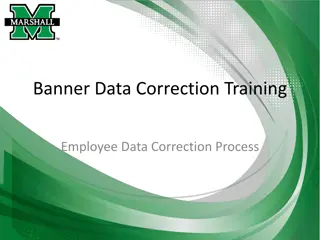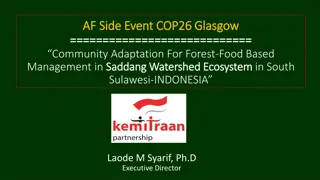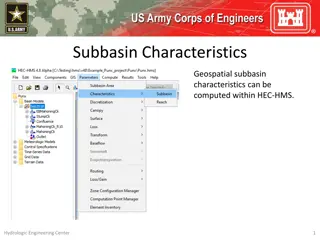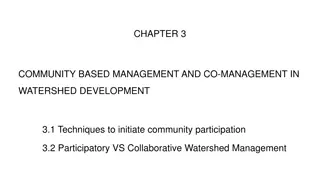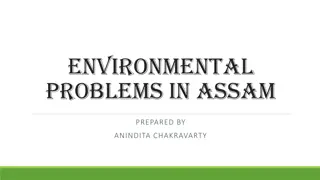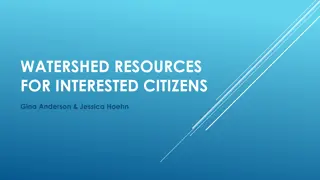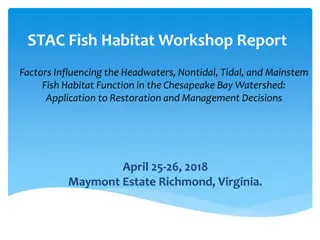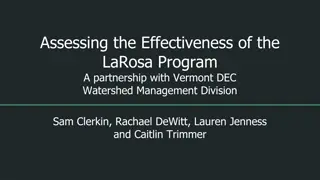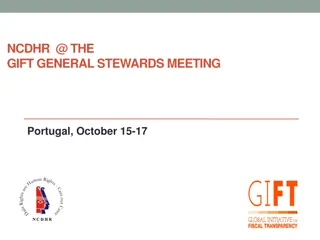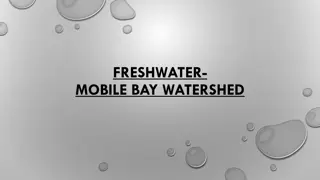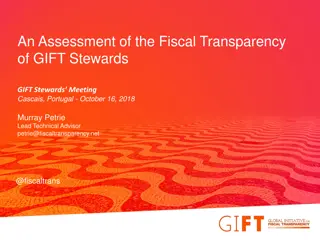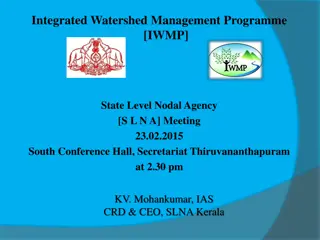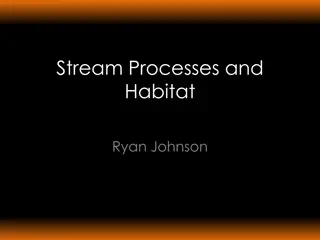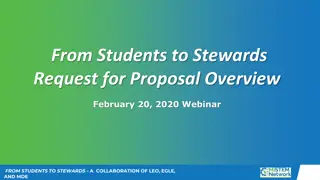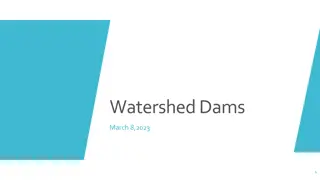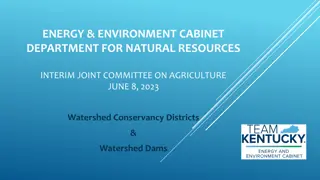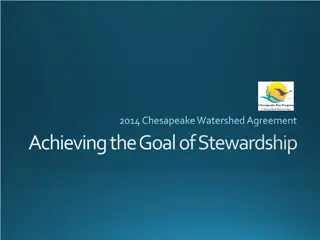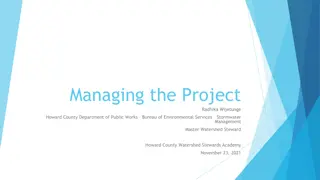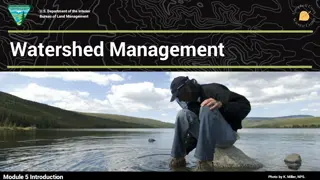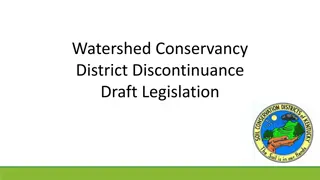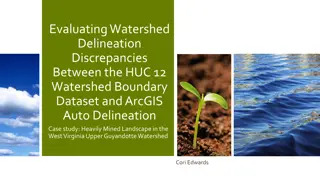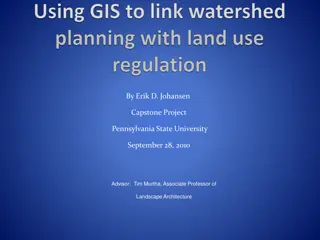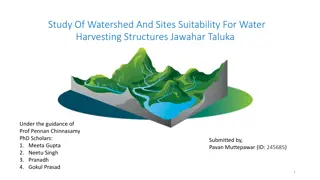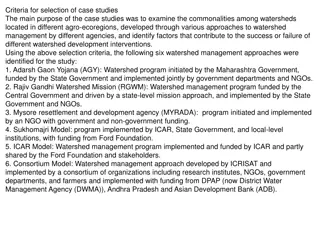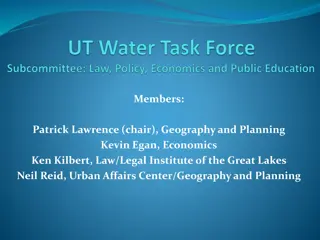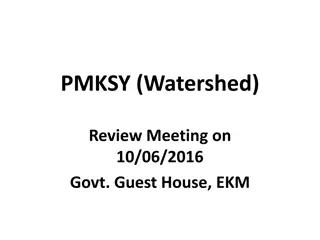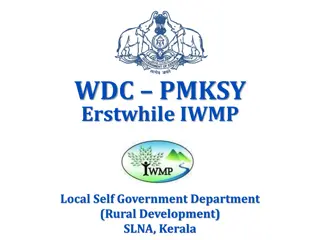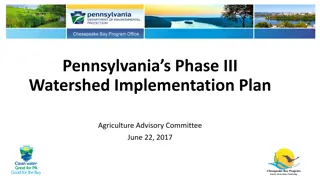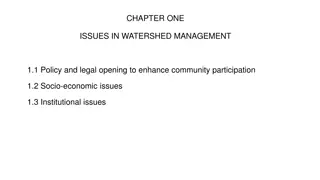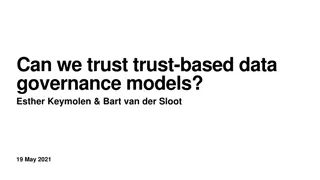Stakeholder Engagement in Northern Colorado Water
Explore stakeholder engagement, collaboration, and water management in Northern Colorado, focusing on the Cache la Poudre watershed. Discover the various uses of the watershed, key groups involved in its preservation, and ongoing projects like the Northern Integrated Supply Project. Join the convers
0 views • 14 slides
Data Management Process for Ensuring Data Integrity
This presentation covers the process of data correction and management within an organization. It explains the roles and responsibilities of Data Stewards and Data Custodians in maintaining data quality, accuracy, and security. Bug-D automates processes to ensure high data integrity, with stewards r
0 views • 10 slides
Enhancing Community Resilience in South Sulawesi: A Sustainable Approach to Climate Adaptation
Empowering communities in the Saddang Watershed Ecosystem, South Sulawesi, Indonesia, to enhance their resilience against climate change. Projects focus on forest-food management, urban climate solutions, coastal community adaptation, and indigenous watershed governance. The initiative aims to stren
4 views • 8 slides
Understanding Subbasin Characteristics in HEC-HMS
Subbasin characteristics play a crucial role in hydrological modeling within HEC-HMS. Before computing these characteristics, the basin model must have georeferenced subbasins in the GIS. Various parameters such as basin slope, relief, elongation ratio, drainage density, and flowpath lengths and slo
0 views • 13 slides
Community-Based Management in Watershed Development
Techniques to initiate community participation in watershed management are crucial for sustainable development. Scholars classify participation levels into different categories, highlighting the importance of ideological motivation and voluntary engagement. The shift from direct intervention to part
0 views • 28 slides
Environmental Challenges in Assam: Solid Waste Management, Deforestation & Watershed Management
Assam faces environmental problems related to solid waste management, deforestation, and watershed management. Solid waste, including municipal, industrial, and biomedical waste, poses a significant threat to human health if not handled properly. Deforestation, the permanent removal of trees for var
0 views • 15 slides
Understanding USDA Watershed Programs for Local Communities
USDA Watershed Programs offer assistance in addressing natural resource issues such as flood control, repairing flood damages, and rehabilitating flood control dams. The three major components - Emergency Watershed Program (EWP), Watershed Protection and Flood Control Program (WPFO), and Watershed R
0 views • 15 slides
Watershed Resources for Interested Citizens
Explore a variety of resources related to watersheds, wetlands, and water monitoring, including tools provided by the U.S. Fish and Wildlife Services National Wetland Inventory. Learn about different types of wetlands, access the Indiana Watershed Group Finder for locating hydrologic unit codes, and
3 views • 18 slides
Factors Influencing Fish Habitat in Chesapeake Bay Watershed Workshop Report
This workshop report delves into the factors affecting fish habitat function in the Chesapeake Bay Watershed, focusing on headwaters, nontidal, tidal, and mainstem areas. It outlines the workshop process, assessment frameworks, and user needs to support restoration and management decisions. The repo
1 views • 31 slides
Understanding TMDL Development in Watershed Management
Explore the essential concepts of Total Maximum Daily Load (TMDL) development in watershed management, including the significance of impaired streams, numeric and narrative criteria for water quality standards, and the process of developing TMDLs to restore and maintain healthy water bodies. Gain in
5 views • 30 slides
Challenges and Efforts for Steelhead Recovery in Salinas River Watershed
Steelhead in the Salinas River watershed have faced a historic lack of documentation and a rapid decline since the 1960s. The current status indicates a threat to their existence, with various factors contributing to their decline. Issues such as water quality, barriers to passage, and human activit
1 views • 11 slides
Evaluating Effectiveness of LaRosa Program in Partnership with Vermont DEC Watershed Management Division
This project aims to assess the LaRosa program's effectiveness through fostering communication, evaluating its impact, and identifying challenges faced by watershed associations. Various methods such as interviews, surveys, and email communication were used to gather insights. Key questions revolved
0 views • 18 slides
Data Governance Issue Assessment Process Overview
The data governance issue assessment process formalizes how data issues are resolved by identifying clear steps to resolution, assigning responsibilities, and ensuring proper documentation. Lead stewards, liaisons, committee members, and support personnel play key roles in this process, which includ
1 views • 12 slides
The GIFT Operating Rules: Changes for a Stronger Champion Network
The GIFT General Stewards Meeting in Cascais, Portugal discussed changes to strengthen and unify the Champion Network. It highlighted the importance of inclusive participation and outlined the roles and responsibilities of GIFT stewards. The meeting emphasized advancing fiscal openness through trans
0 views • 13 slides
NCDHR Gift General Stewards Meeting Overview
The NCDHR Gift General Stewards Meeting in Portugal focused on promoting fiscal transparency, participation of marginalized communities, and tech solutions for accountability. Discussions included motivating citizens on budgets, capacitating groups, and promoting GIFT principles to other organizatio
0 views • 5 slides
Federal Employment Disciplinary Proceedings and Union Stewards Overview
This comprehensive guide covers common issues faced by union stewards in federal employment disciplinary proceedings, including proposed actions, Collective Bargaining Agreement violations, EEO complaints, and disciplinary actions for federal and NAF employees. It outlines the process for misconduct
0 views • 17 slides
Exploring the Freshwater Mobile Bay Watershed
The Mobile Bay Watershed covers a vast area across multiple states, with various rivers and water bodies interconnected through a network of tributaries. Major Alabama rivers, including the Mobile River and the Tombigbee River, flow through this watershed, supporting diverse ecosystems. However, env
0 views • 8 slides
Chesapeake Bay Program Watershed Model Overview
The Chesapeake Bay Program's Watershed Model, presented to STAC in December 2019, provides insights on long-term average pollutant loads and land use dynamics in the Chesapeake Bay watershed. The model incorporates inputs such as land use acres, BMPs, and delivery mechanisms to estimate pollutant lo
0 views • 41 slides
Assessment of Fiscal Transparency Among GIFT Stewards
This assessment analyzes the fiscal transparency of GIFT Stewards and Partners in 20 countries using various data sources. It aims to encourage peer learning, stimulate discussions on enhancing fiscal openness, and promote more robust reforms and OGP commitments. The evaluation highlights improvemen
0 views • 18 slides
Integrated Watershed Management Programme State Level Nodal Agency Meeting Report
The State Level Nodal Agency meeting for the Integrated Watershed Management Programme was held on 23rd February 2015 in Thiruvananthapuram, where various agenda items were discussed, including confirmation of previous meeting minutes, action taken reports, project approvals, and resolving project d
0 views • 54 slides
Understanding Watershed Processes and Habitat Impact
Explore the intricate relationship between stream processes, watershed factors, and habitat effects on local wildlife. Learn how climate, geology, soil, vegetation, water, and land use play crucial roles in shaping ecosystems. Discover the importance of maintaining a healthy vegetative community for
0 views • 27 slides
Factors Influencing Watershed Management Explained by Mr. Anil Swami
Mr. Anil Swami, an Assistant Professor specializing in Rainfed Agriculture & Watershed Management, discusses the factors affecting watershed management. These factors are categorized into watershed characteristics, climatic characteristics, land use patterns, social status, and organization. Watersh
0 views • 18 slides
Elk Creek Wood Replacement Project Overview
This project, led by the Oregon Watershed Enhancement Board in 2009 and documented by Katie Halvorson, focuses on the replacement of wood structures in Elk Creek to enhance watershed function and habitat complexity for juvenile coho salmon. By addressing the lack of large wood, the initiative aims t
0 views • 20 slides
From Students to Stewards: Collaboration Overview and Timeline
Collaboration between LEO, EGLE, and MDE on the "From Students to Stewards" project, focused on enhancing STEM education, community connections, and stewardship. The proposal includes program partners, webinar overview, grant timeline, and contact information for further inquiries.
0 views • 6 slides
Watershed Dams Rehabilitation Program in Kentucky
The Watershed Dams Rehabilitation Program in Kentucky aims to address the critical need for rehabilitating high hazard dams to ensure public safety and prevent economic damage. With funds allocated for grant programs and local sponsor matches, the initiative targets key priority dams identified by t
0 views • 8 slides
Watershed Conservation and Dam Rehabilitation Initiatives Overview
Explore the functions and responsibilities of Watershed Conservancy Districts in maintaining watershed dams, the funding mechanisms for dam rehabilitation projects, and the prioritized dam rehabilitation initiatives in Kentucky. Learn about the Watershed Dam Fund and its role in supporting the rehab
0 views • 8 slides
Achieving the Goal of Stewardship in the Chesapeake Watershed Agreement
The Chesapeake Watershed Agreement aims to increase the number and diversity of local citizen stewards and local governments supporting conservation and restoration activities for healthy local streams, rivers, and the Chesapeake Bay. Recognizing the importance of local involvement, citizen stewards
0 views • 8 slides
Project Management Essentials for Watershed Stewards
Uncover the fundamental aspects of project management through a comprehensive exploration of definitions, processes, constraints, and the role of a project manager. Dive into the core questions that help grasp the essence of a project and understand its overall impact and execution. Explore key resp
0 views • 23 slides
Understanding Watershed Management: Balancing Needs and Resources
Exploring the importance of watersheds in providing natural resources, the consequences of human modifications, and how communities strive to balance human needs with protecting watershed health. This module delves into the sources of community essentials like water, electricity, and heat, emphasizi
0 views • 12 slides
New Procedure for Watershed Conservancy District Discontinuance
A draft legislation proposes a new procedure for discontinuing inactive Watershed Conservancy District boards. Key points include criteria for initiating discontinuance, public notification requirements, voting procedures, and provisions for district boundaries and responsibilities. The legislation
0 views • 6 slides
Evaluating Watershed Delineation Discrepancies in West Virginia
This case study explores differences between NRCS Watershed Boundary Dataset and ArcGIS auto delineation in the Upper Guyandotte Watershed in West Virginia. The project aims to quantify discrepancies, analyze landscape characteristics, examine mining impacts, and assess the variations' effects on hy
0 views • 18 slides
Sustainable Watershed Planning in Stevens County, Washington
The Colville River watershed, known as WRIA 59, is the focus of sustainable watershed planning in Stevens County, Washington. The planning aims to address current and future water needs while protecting and enhancing the water resources within the area. Regulations around water rights, land use, and
1 views • 19 slides
Study of Watershed and Sites Suitability for Water Harvesting in Jawhar Taluka
This project aims to address water scarcity in Jawhar Taluka by studying watershed characteristics and identifying suitable sites for water harvesting structures. The methodology includes DEM analysis using QGIS Grass, watershed delineation, stream extraction, and site suitability assessment based o
0 views • 4 slides
Analysis of Different Watershed Management Approaches in Various Agro-Ecoregions
This study examines six different watershed management approaches implemented in diverse agro-ecoregions, focusing on the commonalities, success, and failures of interventions. The case study of Adarsh Gaon Yojana (AGY) in Maharashtra highlights the principles and approach towards sustainable villag
0 views • 13 slides
Watershed Management Research Projects in Maumee Watershed
Explore five key research tasks focusing on policies, practices, and impacts concerning nutrient loading into Lake Erie from the Maumee Watershed. Projects include examining CAFOs and CAFFs, declaring the Maumee a distressed watershed, regulating nutrients on farmland, addressing residential lawn fe
0 views • 6 slides
Progress Review Meeting for PMKSY Watershed Projects - Financial Updates and Project Status Assessment
The review meeting held on 10/06/2016 at the Government Guest House in EKM discussed the financial progress and project status of PMKSY Watershed Projects in various districts including Kasargode, Kannur, Kozhikode, Malappuram, Palakkadu, and Wayanadu. The detailed analysis included the project cost
0 views • 64 slides
Watershed Development Programme in Kerala: A Comprehensive Overview
The Watershed Development Programme in Kerala underwent significant transformations over the years, evolving from the Integrated Watershed Management Programme to its current form under the Pradhan Mantri Krishi Sinchayee Yojana. The program's implementation involves various institutional mechanisms
0 views • 43 slides
Pennsylvania's Phase III Watershed Implementation Plan
Pennsylvania's Phase III Watershed Implementation Plan focuses on reducing nitrogen, phosphorus, and sediment loading to meet Chesapeake Bay Total Maximum Daily Load requirements by 2025. The plan involves various sectors like agriculture, urban runoff, and forest areas to achieve necessary reductio
0 views • 30 slides
Issues in Watershed Management: Policy, Legal, and Community Participation
Policy and legal frameworks play a crucial role in enhancing community participation in watershed management. Understanding policy impacts, participatory processes, and implementation strategies are key for effective management planning. Definitions of policy, its components, and what it is not are
0 views • 81 slides
Trust-Based Data Governance Models and Their Impact on Personal Data Regulation
This article delves into trust-based data governance models, contrasting them with control-based models in the context of personal data regulation. It explores the challenges and benefits associated with both approaches, emphasizing the emergence of new models centered on trust such as data stewards
0 views • 11 slides

